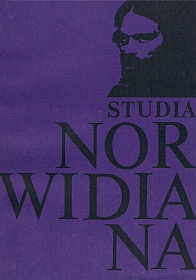Poet of the Stone
Abstract
The word “kamień” (stone) is regarded as a key word in this study. It occurs frequently enough in Norwid’s writings to give us an insight into several of the most essential problems of his work. The analytic traditon we shall follow has been established by S. Brzozowski (whose analysis centred on the word “ruiny”) and K. Wyka (who brought out the metaphor of the sculptor). The complex semantics of “kamień” has been pointed out by M. Tatara in his analysis of the poem Adam Krafft (Section 1).
The motif of “men of stone” conveys the poet’s criticism of a society frequently indifferent to the individual; it also introduces a special kind of dialogue where the collective is attacked via an “anacritical image of immobility” (M. Bachtin; J. Fert) (Section 2). The recurrent motif of an individual stoned by a mob expresses asymmetry of the relation individualxollective; the mob is aggressive, while the individual takes on the appearance of a martyr (Section 3). Norwid also makes frequent use of the motif of pavement, making it into a metonymy of civilization, of city life which stands in sharp conflict with the imponderables and the humanistic tradition. (Not included in the present study is imagery drawing on the antiquity, in particular on pagan Rome, which has been investigated by I. Sławińska) (Section 4).
There is in Norwid’s work, even if never stated expressly but only metaphorically, an idea of a code of stone: since it is impossible for the artist to communicate with his contemporaries, since he feels isolated, he commits his message to stone (as a sculpture, statue, tombstone) he finds a place for himself in the generations-old order of cultural tradition and so engages in a dialogue with God and with mankind (Section 5).
The motif of stone as a foundation of culture occurs many times in Norwid. In his Notatki z mitologii (Notes on Mythology) he describes stone as (a) a sign from heaven, (b) a figure of the Messiah, (c) the cornerstone (Beth-el) lying at the foundation of culture and creating a sacred space. The word "kamień” appears in Norwid’s search for native sources of culture (the drama Krakus) and in his reconstruction of the links of Polish culture with European culture and the Roman tradition. The work of a sculptor carving in stone is an allegory of man’s effort to transform reality (stone, i.e. matter, is transformed by a transcendent idea) and to continue tradition, the heritage of mankind (Section 5).
Copyright (c) 1987-1988 Studia Norwidiana

This work is licensed under a Creative Commons Attribution-NonCommercial-NoDerivatives 4.0 International License.





